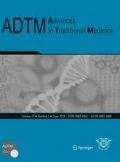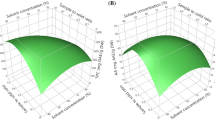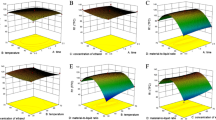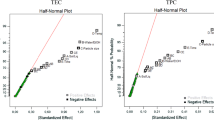Abstract
The selection of appropriate conditions for increasing the extraction efficiency is important. The response surface method (RSM) is a statistical and mathematical technique which it can be used to examine the dependence between the responses with variables in a process and also determine the optimal conditions. In this study, the experimental design of General full factorial (GFF) was used by Minitab 17 software. The variables were time (30, 60 and 90 min), solvent (water, methanol and n-hexane) and method (maceration and ultrasound-assisted extraction). The main effects and also interaction terms were investigated on amounts of total phenolic content (TPC), total flavonoid content (TFC) and the antioxidant activity (according to DPPH, FRAP, IC50 and BCB) of extract of Arenaria hispanica L.. A multiple regression, first degree model was used to express the responses. An analysis of variance (ANOVA) with 95% confidence level was then carried out for each response (TPC, TFC, FRAP, IC50 and BCB) in order to test the model significance and suitability. In optimum conditions, the maceration method was optimum method for TPC, FRAP and BCB, while for TFC was ultrasound-assisted extraction. Water was optimal solvent for TPC, FRAP and BCB, but methanol was obtained as the best solvent for TFC and IC50. Also, the extraction time of TPC was 60 min and for TFC, IC50, FRAP and BCB obtained 30 min. The mounts of TPC, TFC, IC50, FRAP and BCB in the optimum conditions obtained 173.93 ± 0.50 (mg GAE/g extract), 184.27 ± 4.04 (mg QC/g extract), 0.69 ± 0.03 (mg/mL), 734.80 ± 2.02 (mmol Fe2+/g exctract) and 21.23 ± 0.22; respectively.


Similar content being viewed by others
References
Aeschbach R, LoEliger J, Scott BC, Murcia A, Butler J, Halliwell B, Aruoma OI (1994) Antioxidant action of thymol, carvacrol, 6- gingerol, zingerone and hydroxytyrosol. Food Chem Toxicol 32:31–36
Antolovich M, Prenzler PD, Patsalides E, Mcdonald S, Robards K (2002) Methods for testing antioxidant activity. Analyst 127:183–198
Azwanida NN (2015) A review on the extraction methods use in medicinal plants, principle, strength and limitation. Med Aromat Plants 4:1–6
Bachcecitapar MK, Karadag O, Aktas S (2016) Estimation of sample size and power for general full factorial designs. J Stat Stat Actuar 9:79–86
Benzie IFF (1996) Lipid peroxidation: a review of causes, consequence, measurement and dietary influences. Int J Food Sci Nutr 47:233–261
Benzie IF, Strain JJ (1999) Ferric reducing/antioxidant power assay: direct measure of total antioxidant activity of biological fluids and modified version for simultaneous measurement of total antioxidant power and ascorbic acid concentration. Method Enzymol. 299:15–27
Chen KN, Chen MJ (2009) Statistical optimization: response surface methodology. In: Erdogdu F (ed) Optimization in food engineering. CRC Press, Boca Raton, pp 115–116
Chen F, Sun Y, Zhao G, Liao X, Hu X, Wu J, Wang Z (2007) Optimization of ultrasound-assisted extraction of anthocyanins in red raspherries and identification of anthocyanins in extract using high- performnce liquid chromatography- mass spectrometry. Ultrason Sonochem 14:767–778
Cheok CY, Chin NL, Yusof YA, Law CL (2012) Extraction of total phenolic content from Garciniamangostana Linn. hull. I. Effects of solvents and uv–vis spectrophotometer absorbance method. Food Bioproc Tech 5:2933–2933
Dordoevic S, Cakic M, Amr S (2000) The extraction of apigenin and luteolin from the sage (Salvia officinalis L.) from Jordan. FU Phys Chem Technol 1:87–93
Estevez M, Cava R (2006) Effectiveness of rosemary essential oil as inhibitor of lipid and protein oxidation: contradictory effects in different types of frankfurters. Meat Sci 72:348–356
Falleh H, Ksouri R, Lucchessi ME, Abdelly C (2012) Ultrasound-assisted extraction: effect of extraction time and solvent power on the levels of polyphenols and antioxidant activity of Mesembryanthemum edule L. Aizoaceae shoots. Trop. J. Pharm. Res. 11:243–249
Frankel EN (1991) Recent advances in lipidoxidation. J Sci Food Agric 54:495–511
Juntachote T, Berghofer E (2005) Antioxidative, properties and stability of ethanolic extracts of Holy Basil and Galangal. Food Chem 92:193–202
Katalinic V, Milos M, Kulisic T, Jukic M (2006) Screening of 70 medical plant extracts for antioxidant capacity and total phenols. Food Chem 94:550–577
Robards K, Kerr A, Patsalides E (1988) Rancidity and its measurement in edible oils and snack foods: a review. Analyst 113:213–224
Saha K, Lajis NH, Israf DA, Hamazah AS, Khozirah S, Khamis S, Syahida A (2004) Evaluation of antioxidant and nitric oxide inhibitory activities of selected Malaysian medicinal plants. J Ethnopharmacol 92:263–267
Singleton VL, Rossi JA (1965) Colorimetry of total phenolics with phosphomolybdic-phosphotungstic acid reagents. Am J Enol Vitic 16:144–158
Tamaino A, Cimino F, Zimbalatti V, Venuti V, Salfaro V, Pasquale AD, Saija A (2005) Influence of heating on antioxidant activity and chemical composition of some spice essential oil. Food Chem 89:549–554
Theriault M, Caillet S, Kermash S, Lacroix M (2006) Antioxidant, antiradical and at mutagenic activity of phenolic compounds present in maple products. Food Chem 98:490–501
Velickovic DT, Nikolova M, Ivancheva SV, Stojanoviv JB, Veljkovic VB (2007) Extraction of flavonoids from garden (Salvia officinalis L.) and glutinous (Salvia glutinosa L.) sage by ultrasonic and classical maceration. J Serb Chem Soc 72:73–80
Vinatoru M (2001) An owerview of the ultrasonically assisted of bioactive principles from herbs. Ultrason Sonochem 8:303–313
Woisky RG, Salatino A (1998) Analysis of propolis: some parameters and procedures for chemical quality control. J Apic Res 37:99–105
Acknowledgements
The authors gratefully acknowledgment the support of this research by Bojnourd Branch, Islamic Azad University, Bojnourd-Iran.
Funding
Not applicable.
Author information
Authors and Affiliations
Corresponding author
Ethics declarations
Ethical statement
This article does not contain any studies with human participants or animals performed by any of the authors.
Conflict of Interest
Malihe Samadi Kazemi has no conflict of interest. Somayeh Firouzeh has no conflict of interest.
Additional information
Publisher's Note
Springer Nature remains neutral with regard to jurisdictional claims in published maps and institutional affiliations.
Rights and permissions
About this article
Cite this article
Kazemi, M.S., Firouzeh, S. Evaluation of the extraction process of Arenaria hispanica L. using response surface methodology on amounts of total phenolic content, total flavonoid content and the antioxidant activity. ADV TRADIT MED (ADTM) 22, 325–332 (2022). https://doi.org/10.1007/s13596-020-00539-2
Received:
Accepted:
Published:
Issue Date:
DOI: https://doi.org/10.1007/s13596-020-00539-2




